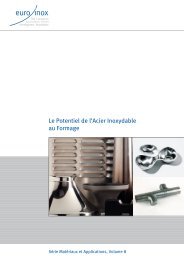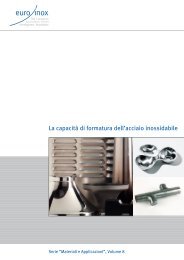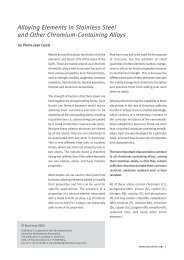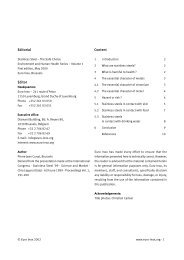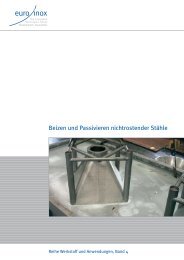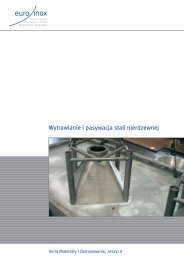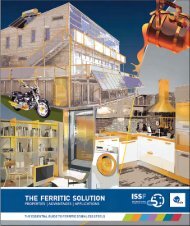Innovative Stainless Steel Applications in transport ... - Euro Inox
Innovative Stainless Steel Applications in transport ... - Euro Inox
Innovative Stainless Steel Applications in transport ... - Euro Inox
You also want an ePaper? Increase the reach of your titles
YUMPU automatically turns print PDFs into web optimized ePapers that Google loves.
New challenges have to be met <strong>in</strong> both the design and manufacture of sandwich panels,<br />
compared to conventional steel structures. Other than bend<strong>in</strong>g loads – for which the<br />
panels are most suitable – shear and po<strong>in</strong>t load<strong>in</strong>g, which decrease the local strength of<br />
panels welded from th<strong>in</strong> sheet materials, must also be taken <strong>in</strong>to account. Further<br />
theoretical strength challenges are <strong>in</strong>troduced by jo<strong>in</strong><strong>in</strong>g and connect<strong>in</strong>g the panels to<br />
each other and to structures.<br />
New factors also have to be considered <strong>in</strong> panel manufacture. Manufactur<strong>in</strong>g the core to<br />
tolerances sufficient to allow flatness <strong>in</strong> welded panels is a key prerequisite for panel<br />
applications. For this, jo<strong>in</strong><strong>in</strong>g methods other than arc weld<strong>in</strong>g, such as laser or resistance<br />
weld<strong>in</strong>g, adhesive bond<strong>in</strong>g or mechanical jo<strong>in</strong><strong>in</strong>g, have to be used. These br<strong>in</strong>g new<br />
possibilities but also <strong>in</strong>troduce challenges and limitations to the design, manufacture,<br />
use and ma<strong>in</strong>tenance of panels (Kujala et al. 2003).<br />
3.2.1 Design pr<strong>in</strong>ciples of sandwich panels<br />
The structural design of all-steel sandwich panels can be divided <strong>in</strong>to two parts:<br />
calculation of the elastic response of the structure and consideration of strength criteria.<br />
Figure 51 shows a chart of the design process accord<strong>in</strong>g to Romanoff & Kujala (2002).<br />
Figure 51. A schematic of the all-steel sandwich panel design process (Romanoff & Kujala<br />
2002 p. 20).<br />
The design of all-steel panels starts with def<strong>in</strong><strong>in</strong>g panel geometry, loads, boundary<br />
conditions and strength criteria. Both ma<strong>in</strong> dimensions and core geometry are <strong>in</strong>cluded<br />
<strong>in</strong> def<strong>in</strong><strong>in</strong>g panel geometry. Ma<strong>in</strong> dimensions are generally length, width and thickness.<br />
Core geometry <strong>in</strong>cludes surface and core sheet thickness, core angles, etc. There are<br />
several measurements to describe core geometry, depend<strong>in</strong>g on the chosen core type.<br />
65








